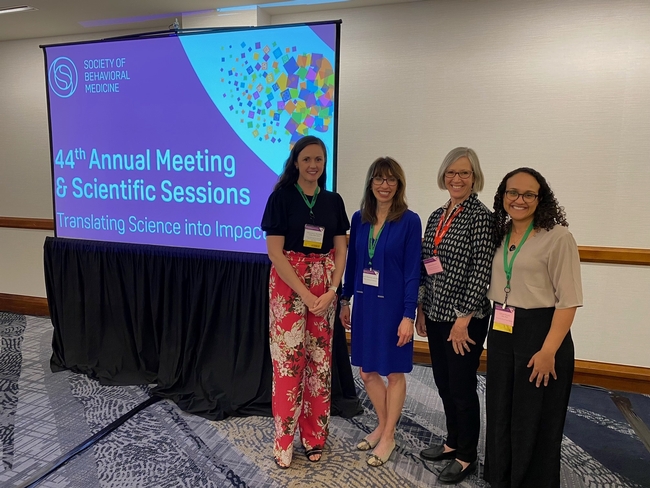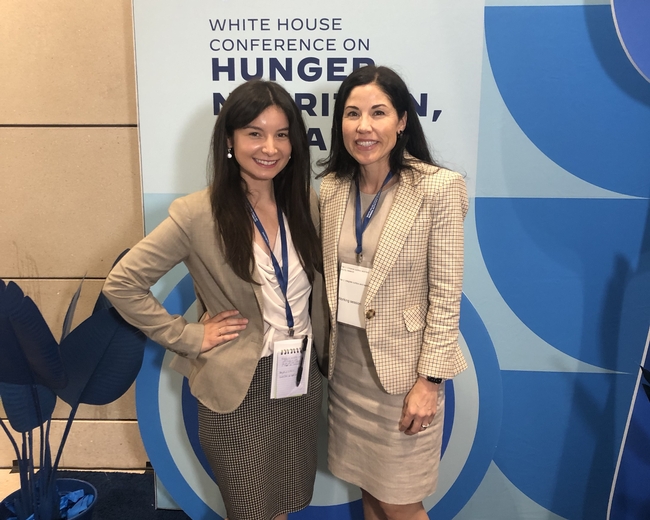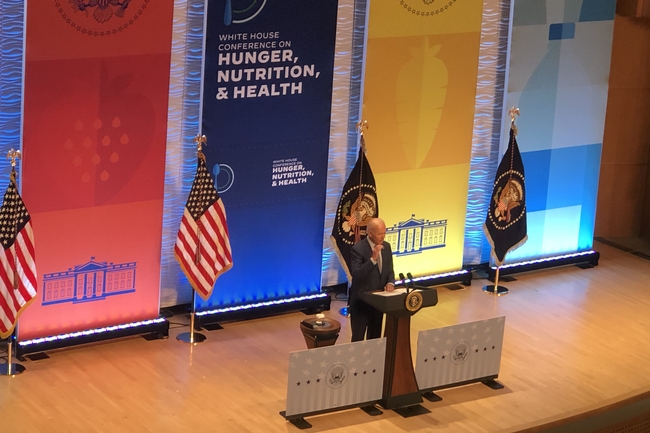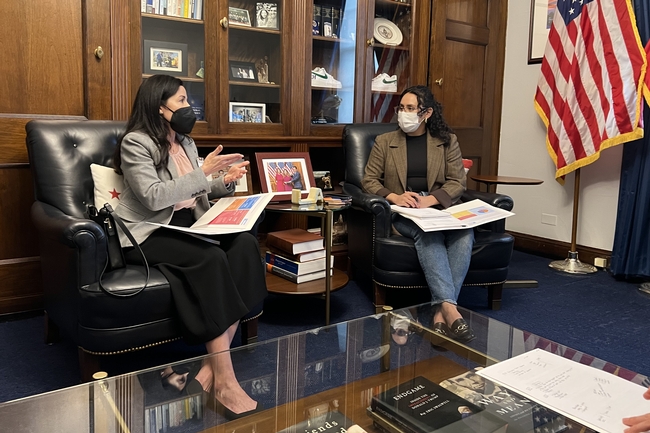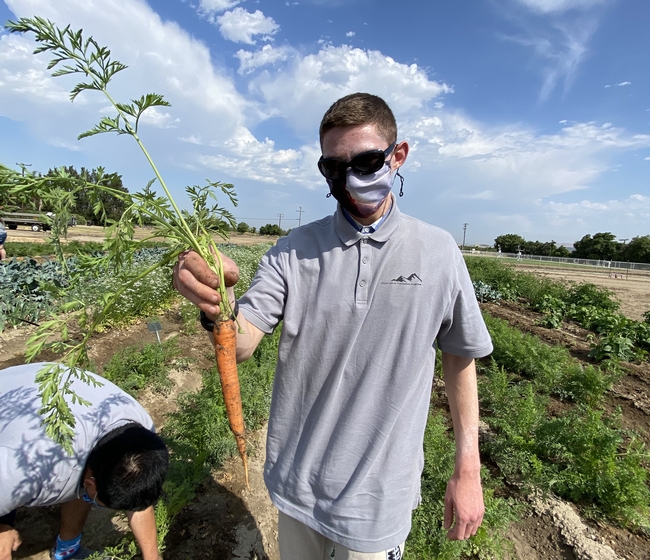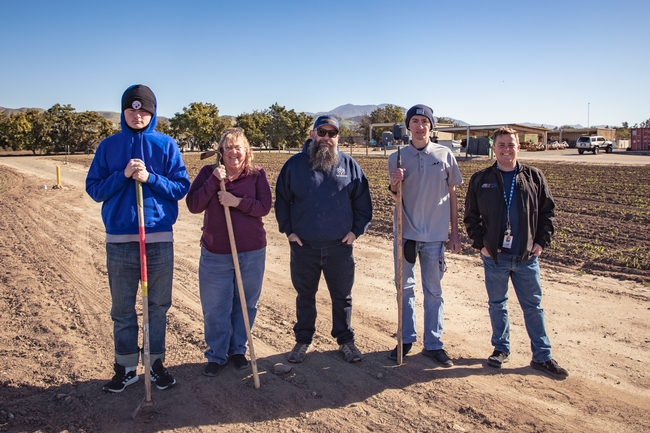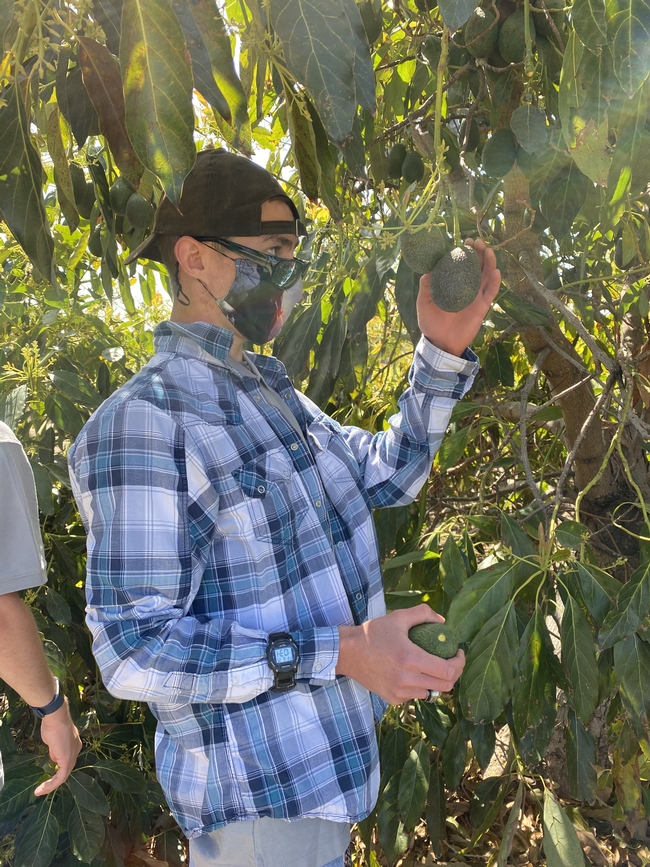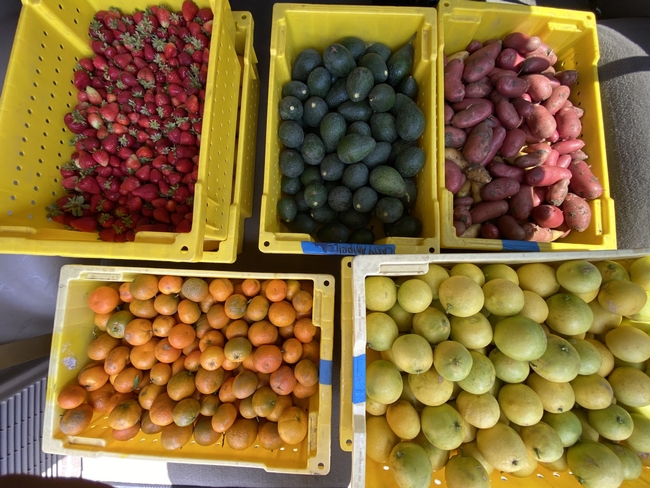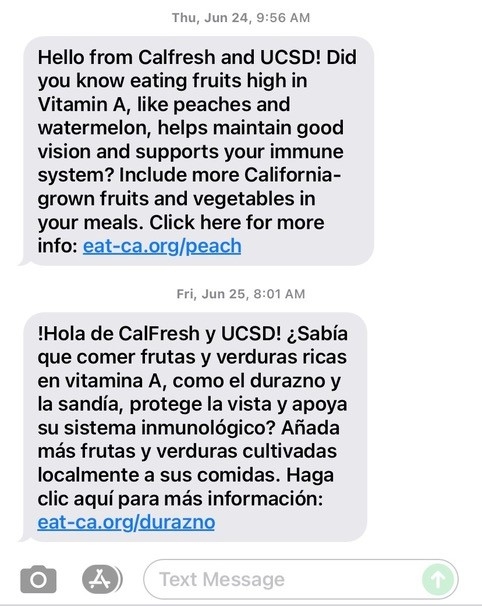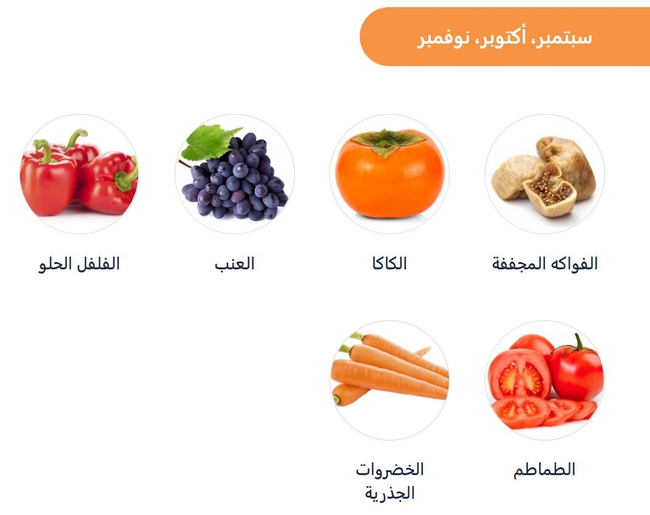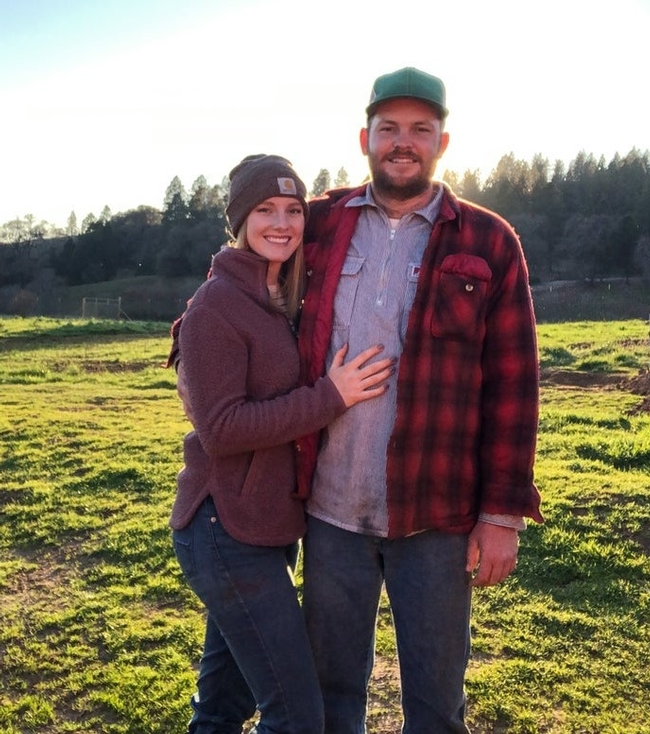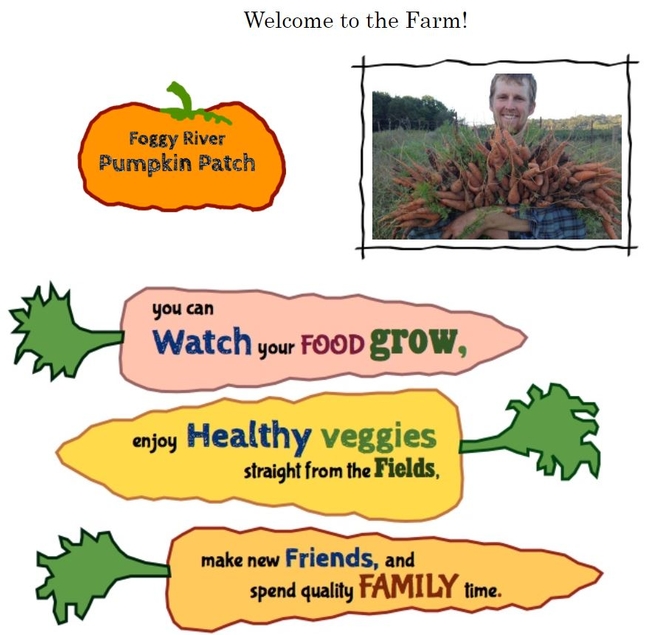- Author: Michael Hsu
Nutrition Policy Institute researcher developed techniques that help identify effective public health programs
When Suzanne Rauzon and May Wang were in the master's of public health program at the University of California, Berkeley during the mid-1980s, Wang knew that her classmate had unique brilliance to bring to their field.
“You know how you vote for the person in high school who's most likely to succeed? That was Suzanne,” said May Wang, a professor of community health sciences in the UCLA Fielding School of Public Health. “Suzanne was always ahead of every one of us; she was so visionary and forward-thinking and I think we were all – to be honest – a little bit in awe of her.”
Decades later, as Rauzon prepares to retire in January 2024 as director of community health at the Nutrition Policy Institute, she has fulfilled that exceptional promise. Her many contributions are helping communities identify the most effective programs to benefit public health.
Lorrene Ritchie, director of NPI (an institute under UC Agriculture and Natural Resources), said that Rauzon has played a pivotal role in translating research findings into community action and policy change. She added that Rauzon has brought an extraordinary combination of strategic vision for the overall direction of nutrition studies and tactical savvy to anticipate the needs of project funders and communities.
“Few people can bring both of those skills – efficiently complete the day-to-day tasks as well as be a big-picture thinker,” Ritchie said. “She has been so instrumental in contributing to NPI's impacts.”
A unique skill set to tackle complex challenges
Part of what makes Rauzon unique in her field is her extensive experience in the private sector. After attaining her master's degree, Rauzon developed a comprehensive employee worksite wellness initiative at a telecommunications company – a new set of programs that led the field in the 1990s.
“Suzanne was, is and has always been very visionary,” Wang said.
After years in the corporate space, however, Rauzon leaped at the chance to return to academia (and reunite with Wang) in 2001 at UC Berkeley's Center for Weight and Health, a precursor to NPI. Working with center co-director Patricia Crawford, Rauzon said the project to investigate the effects of sugar-sweetened beverages was a “perfect fit” for her.
Concerned with rising childhood obesity, the researchers studied the significant differences in health outcomes for students in high schools that limited access to beverages such as soft drinks, versus schools that did not.
“That field in general – looking to limit sugar-sweetened beverages – started with a focus in schools, and expanded into other environments (such as college campuses) over the years, and has continued to be a focus in public health,” Rauzon said, “all the way up to work now on limiting sugar-sweetened beverages access in other public institutions.”
Rauzon's change-management and communication skills also were crucial in studying the revolutionary School Lunch Initiative in the Berkeley Unified School District – a collaboration with chef Alice Waters' Chez Panisse Foundation and the Center for Ecoliteracy to engage young people in the growing and preparation of food. Brought in to evaluate the efficacy of the program, Wang and Rauzon found they had to alter their mindset and methods when working with partners who were responding to oft-changing circumstances.
Rauzon's cross-sector perspective, practical know-how and people skills in cultivating positive relationships with district staff and educators were instrumental in successfully completing studies with as much rigor as possible in real-world settings such as schools.
The researchers created new analytical tools to evaluate health interventions developed by communities themselves – as opposed to programs engineered by academics and applied to community members with the expectation that they would accept it.
“Most researchers, to be honest, are still striving to do that with communities,” Wang said. “It is an incredibly challenging task because communities will do what they want to do – and what they need to do – to respond to the needs of people.”
Wang, who now trains academics in community-based participatory research, said that the ground-up paradigm has been shaped by Rauzon's thinking. “A lot of the ideas I have today really came about from our work together on the School Lunch Initiative,” Wang said.
A legacy of new methods, mentoring early-career professionals
One of Rauzon's longest-running – and most complex – projects has been the evaluation of community health interventions across the country, including a variety of Kaiser Permanente initiatives to promote healthy eating and physical activity.
“What was interesting about that work was we really were trying to understand the combined effects of doing a lot of different things that are related – and to see the overall effect that can have on the community,” said Rauzon, noting that interventions ranged from nutrition classes to policy changes to park and bike-safety improvements.
Wang said some of their findings, particularly from one study in Los Angeles County, suggest that effective programs are early childhood interventions (including an emphasis on breastfeeding), home visitations by nurses and social workers to vulnerable households, and partnerships with retailers to make healthy food choices more accessible.
In the process, the researchers helped pioneer new research tools – including interdisciplinary “systems mapping” approaches in which computer scientists discern linkages among various programs and their effects, and the highly influential “community intervention dose index” concept that can be used to evaluate multiple intervention strategies within a community.
In addition to Rauzon's contributions in research and evaluation, Ritchie also highlighted her role in supervising and mentoring students and NPI staff and researchers during her 20-plus years with the UC – the role in which Rauzon takes the most pride.
“While I made a contribution to community health in effective interventions and how to measure them,” Rauzon said, “I would say personally the most rewarding part of the work I've done over the last couple of decades is seeing the growth and development and advancement of people who have worked for me and who have really taken off in their own careers – that to me has been immensely satisfying.”
As an emeritus researcher, Rauzon will continue to support NPI professionals and their research, and she added that she's excited to embark on a new partnership – with her husband, a geographer – to mitigate impacts of climate change on human and environmental health across the globe.
People interested in supporting Rauzon's legacy and the ongoing work in health and nutrition can donate to NPI's Student Fellowship, which provides students from underrepresented groups the opportunity to work on NPI research and be mentored by NPI researchers.
- Author: Mike Hsu
Researchers contribute recommendations for national strategy on hunger, nutrition, health
At the first White House Conference on Hunger, Nutrition and Health convened since 1969, President Biden announced on Sept. 28 a national strategy “to end hunger in America and increase healthy eating and physical activity by 2030 so fewer Americans experience diet-related diseases.” Much of the foundational research undergirding the strategy has been informed in part by the Nutrition Policy Institute, a program of UC Agriculture and Natural Resources.
“Science is the work of many – and no one study answers all the questions – but we have a tremendous body of work that has contributed to this conference, building from all the programs and changes that were made from the last conference,” said NPI director Lorrene Ritchie.
The original Nixon-era conference produced about 1,800 recommendations – and 1,600 were eventually implemented in the subsequent years, according to Stacy Dean, U.S. Department of Agriculture Deputy Under Secretary for Food, Nutrition and Consumer Services.
A litany of far-reaching programs grew from or were propelled by the 1969 conference: the School Breakfast Program, WIC (the Special Supplemental Nutrition Program for Women, Infants and Children), SNAP (the Supplemental Nutrition Assistance Program)-Ed and CalFresh Healthy Living UC, the Expanded Food and Nutrition Education Program, and more.
This history illustrates the potential for sweeping change from this 2022 conference – which gathered about 500 experts and advocates (with 1,000 more participating online) – and from the national strategy that represents the Biden-Harris administration's “playbook.”
“Does that document have everything in it that we would like? No – but, oh my goodness, if we could accomplish all the things that they've laid out, what a transformational impact it would have,” said Ritchie, adding that she was thrilled that the highest levels of government are prioritizing hunger and nutrition-related chronic disease.
Including beverages in the conversation
In the course of gathering ideas and input from across the country, conference organizers asked Christina Hecht, NPI senior policy advisor, to author and submit NPI recommendations on encouraging the public to choose water instead of sugary drinks. Those suggestions – which range from including water in the “MyPlate” dietary guideline graphic to ensuring that every public school has a water bottle-filling station – crystallized extensive, rigorous scholarship by a broad community.
“NPI's recommendations were built on lots of work by many water researchers and advocates over the years; they're based on many years of thinking by many people,” Hecht said.
Christina and Ken Hecht, NPI policy director, also submitted recommendations as part of the Sugar-Sweetened Beverage Reduction Workgroup, which brings together experts from national, state and local organizations. Several of their key proposals, such as targeting the marketing of sugary drinks and clarifying front-of-package nutrition labels, appear as recommended steps in the national strategy document.
Other nutrition policy changes compiled by Christina Hecht – like updating the Federal Food Service Guidelines used on federal properties and in federal programs – are also reflected in the national strategy, albeit without specifically mentioning sugary drinks. Nonetheless, Hecht believes doors have been opened for future discussions that could incorporate and promote healthy beverages.
“What those doors require are continuing to develop the evidence base, continuing to translate and share the evidence base, and continuing the advocacy to bring that evidence base to the attention of decision makers,” she said.
University of California setting an example
Suzanna Martinez, an NPI-affiliated researcher who attended the White House conference, said she hopes the convening generates momentum for two bills before Congress that would help alleviate food insecurity in higher education: one that provides funding for campuses to address students' basic needs, and another that reduces barriers to SNAP (Supplemental Nutrition Assistance Program, formerly known as food stamps). The national strategy document explicitly acknowledges that “SNAP's college student eligibility restrictions are out of date given the current population who seek higher education credentials.”
Martinez, an associate professor in the Department of Epidemiology and Biostatistics at University of California San Francisco, was invited to the conference because she's part of a group driving the UC's effort to halve the number of students facing food insecurity across the system by 2030. That commitment, and UC Berkeley's work on basic needs, were highlighted by Second Gentleman Douglas Emhoff during the closing plenary session.
“The work that we're doing here in California tends to set the stage for what happens in other states,” said Martinez, who also cited California's pioneering effort to provide meals for all public school students.
NPI's ongoing work evaluating universal school meals in California and other states is just one example of how its academics and staff are refining innovative programs so they can be adopted more effectively and broadly (perhaps nationally). In fact, the White House identified “healthy school meals for all” as the top strategy for improving food access and affordability, and Ritchie applauds the administration's consistent emphasis on early interventions for healthier outcomes.
“The earlier you can create healthy habits – meaning in utero all the way through childhood – the more likely you are going to have adults who don't end up with nutrition-related chronic diseases,” she explained. “The last thing you want to do is to wait until people are really sick before they start to change their habits.”
Another overarching theme that excites Ritchie is the national strategy's “whole of government” approach to addressing a host of nutrition and hunger issues. One example is how the strategy calls for agencies not traditionally associated with food to contribute to reducing waste, such as the Department of the Treasury clarifying tax benefits for businesses that donate food.
“Throughout the document, over and over again, there are countless examples of creating synergies across government agencies and with local and state governments that can help move the needle,” Ritchie said. “It's just this kind of bold call to action that we really need.”
- Author: Mike Hsu
Partnership with Esperanza Education Center provides blueprint for other adult transition programs
For students at Esperanza Education Center, an adult transition program serving students with disabilities in south Orange County, there was something deeply satisfying about handpicking 2,000 pounds of avocados.
“There's a tangible, visual element where you're like, ‘Wow, I did that – I did it, I can see it, I can feel it in my bones and my muscles,'” said Ray Bueche, principal of the school in Mission Viejo, within the Saddleback Valley Unified School District. “There's a real sense of accomplishment that you're seeing in some of these students.”
Ranging in age from 18 to 22, the students are in an adult education program that helps advance their independent living skills and prepare them for meaningful work and careers. They are able to experience the thrill of the harvest – and a variety of other farming activities – through the school's innovative partnership with UC South Coast Research and Extension Center, a UC Agriculture and Natural Resources facility that supports researchers and delivers outreach and education programs.
Given UC ANR's emphasis on workforce development, Jason Suppes, a community education specialist at South Coast REC, contacted Bueche in 2019 about a potential collaboration. While Esperanza has many partnerships with retail stores and nonprofits that give students invaluable work experiences, none of them offer the farm environment that South Coast REC could provide.
“Part of developing [our students] is getting a wide range of opportunities in a variety of vocational areas,” Bueche explained. “Agriculture is one that's very hard for us to find.”
Program ‘wildly successful' from beginning
Unlike other job sites that bring the students in less frequently, South Coast REC committed to hosting the young people every week for three hours (COVID-19 measures permitting), with Suppes and colleague Tammy Majcherek leading them in planting, weeding, maintenance, harvesting and more.
“We can provide opportunities for students to learn skills that could help them potentially find employment in a garden center, in a nursery, at landscapers,” Suppes said. “The program was wildly successful out of the gate.”
Mike Seyler, an Esperanza teacher who accompanies the students to South Coast REC, has seen firsthand the positive impacts of the partnership. He said one student – who at first balked at the idea of being outside, getting dirty and performing physical labor – eventually grew to like the work and took great pride in pulling carrots from the ground and sharing them with his family.
“To physically actually ‘see' the work you did – they don't always get to do that,” Seyler said. “It was cool to see someone, who didn't necessarily like being outdoors, really enjoy it now.”
The change of pace – and place – was especially beneficial for one young woman at Esperanza. Bueche said the nature of the work and the setting helped the student grow socially, as she relished the teamwork and camaraderie needed to accomplish their goals on the farm.
“We really saw a different person come out through her experiences there – she felt more self-confident; she was more personable with people; she was talking more,” said Bueche, who added that she has leveraged the skills she gained into a paid work-based learning experience with a local retailer.
Students bring produce to school, community
All students benefit from Esperanza's partnership with South Coast REC, as surplus produce from the center's fields is donated to make healthy school lunches. In addition, students use REC-grown fruits and vegetables at their monthly pop-up restaurant, where they hone skills in preparing and serving a three-course meal.
Their peers, who harvested the produce, derive immense satisfaction from seeing the fruits of their labor go directly to the school.
“They're able to enjoy eating the stuff that they're working for,” Seyler said. “And then they see everyone else enjoying it, and I think that really translates well for these guys.”
The students also played a prominent role in an avocado sale last summer, for which they picked 2,000 pounds of produce, bagged the fruit in 10-pound bags and then distributed preorders to the public from a stand at South Coast REC. Proceeds from the event were used to purchase farm tools, shirts and other gear.
“It was an incredible success – everyone loved the avocados,” Bueche said. “The students loved it; the parents came out; community members supported it.”
Those successes illustrate the power of a strong partnership; the South Coast REC team, in fact, received the school's “Community Partner of the Year” Award for 2020-21, for persevering through the pandemic to deliver the beneficial programs for students.
Over the last two years, Suppes and Bueche – through a lot of creativity and some trial and error – have sketched a roadmap for growing productive relationships between similar organizations and adult transition programs. And after presenting those results to colleagues, other local school districts and nonprofits such as Goodwill and My Day Counts have contacted South Coast REC to provide similar experiences for community members.
- Author: Mike Hsu
The buzz or chirp of an incoming text message started some San Diego County residents on the path to a healthier diet during this past year. In September 2020, most CalFresh participants in the county – more than 172,000 households – began receiving monthly text messages about the benefits of California-grown fruits and vegetables as part of a pilot program.
This novel approach to delivering nutrition messages to California food assistance program participants was developed by a partnership of the Nutrition Policy Institute of UC Agriculture and Natural Resources, the UC San Diego Center for Community Health and the County of San Diego Health and Human Services Agency, which administers CalFresh in the county.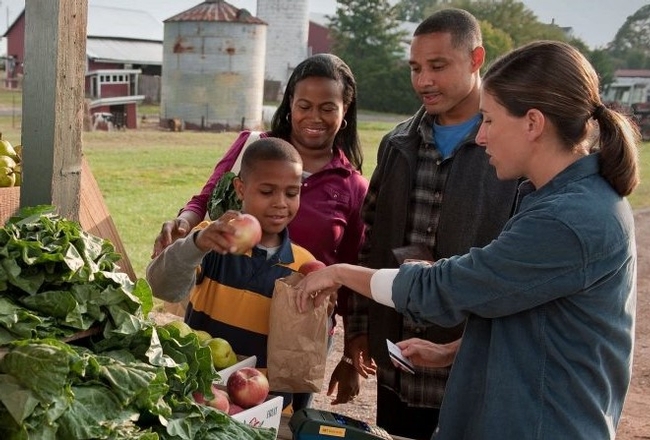
The HHSA, which had been using its text messaging platform to send administrative reminders and alerts, was receptive to using the tool for sending nutrition-focused information. NPI and CCH partnered with ideas42, a firm that applies behavioral science to solutions for social change, to develop a series of five text messages promoting California-grown fruits and vegetables.
The text messages – originally delivered in English and Spanish, with the addition of Arabic beginning in July 2021 – were friendly and conversational in tone.
“In a text, you have very few characters you're communicating with people, so we wanted to make sure we were using cutting-edge behavioral science to construct those messages to have the most impact,” said Wendi Gosliner, NPI senior researcher and policy advisor.
Each text included a link directing recipients to a website developed as part of the project, with information on selecting, storing and preparing California-grown fruits and vegetables; health benefits; tips to reduce food waste; and recipes – including TikTok videos.
Initially running from September 2020 to March 2021, the pilot program was well-received. Nearly 90% of CalFresh participants responding to a survey said they appreciated receiving the texts. “It is very important for us to eat healthy, to teach our children to eat healthy,” wrote one participant. “I love the recipes…they're so delicious and easy to make…I'm very, very grateful for the help because without you guys, I would be struggling more and I just want a better life for my children.”
Gosliner said it was encouraging to see that two-thirds of the approximately 5,000 survey respondents reported eating more California-grown fruits and vegetables after receiving the messages, and 85% expressed a desire to see more texts.
“What we see is that there's definitely a decent-sized population of people participating in CalFresh –now this is just in San Diego County but imagine the entire state – who would benefit from having this kind of information available to them,” Gosliner said. “And there is at least a subset of people who really liked it.”
UC San Diego's Center for Community Health was instrumental in facilitating the partnership between UC ANR and the HHSA. Further, CCH, in partnership with the San Diego County Childhood Obesity Initiative, formed a community council composed of residents representing diverse communities throughout San Diego County. Together, the council facilitated CalFresh participants to take part in focus groups, which provided feedback and guidance on the messaging and design for online resources. Gosliner said the success of the text program has been a direct result of community input and involvement.
“The Center for Community Health-led focus groups were integral to ensuring CalFresh resources were accessible and informative to a wide range of CalFresh participants, and local individuals and families more broadly,” said Blanca Meléndrez, executive director at the UC San Diego Center for Community and Population Health, Altman Clinical Translational Research Institute. “In the process, the text-based campaign also placed a greater focus on the local production of nutritious fruits and vegetables, ensuring access to healthy and nutritious food in all communities, and building new streams of income for the region's farmers and producers.”
This effort also suggests a simple way to reach CalFresh participants and bridge gaps between the Supplemental Nutrition Assistance Program and programming that offers nutrition education and healthy eating resources.
“By combining UCSD and UC ANR knowledge about healthy eating with our outreach capability, we are able to reach thousands of families via text message each month,” said Michael Schmidt, human services operations manager for the HHSA. “With the click of a button, these families are provided with resources to assist them in making healthier lifestyle choices, supporting a region that is building better health, living safely and thriving.”
The effort has been so effective that HHSA has asked for additional messages, beyond the original five months' worth of texts and resources.
“The partnership between UC ANR's Nutrition Policy Institute, UC San Diego's Center for Community Health, the County of San Diego Health and Human Services Agency and San Diego County community residents brought together a great team to develop an innovative, technology-based intervention,” said Shana Wright, San Diego County Childhood Obesity Initiative co-director at CCH. “Each partner provided knowledge, resources and assets that enhanced the project beyond the initial pilot phase, exceeding preliminary expectations.”
Gosliner said the pilot program has been a “great example and wonderful experience” of partnership in action.
“You can sit with your research or program ideas for a long time but if you don't have people who can help you implement them, then they really aren't helpful in any way,” she said. “In this case, it was just a nice combination of an idea…with partners who wanted to work to make something happen.”
- Author: Rachael Callahan
- Author: Cooper Limon
The COVID-19 pandemic hit farmers hard. Supply chains were disrupted and even non-traditional agritourism revenue streams such as hay mazes and on-farm events had to be canceled due to shelter-in-place mandates.
On the other hand, demand for local farm products skyrocketed, and thus many farmers and ranchers needed a quick pivot strategy and a set of new skills.
UC Sustainable Agriculture Research and Education Program (SAREP) was well-positioned to support this shift toward direct sales, pulling in trusted community partners and experienced farmers and ranchers to put together a comprehensive webinar series, “Agritourism and Direct Sales: Best Practices in COVID Times and Beyond”.
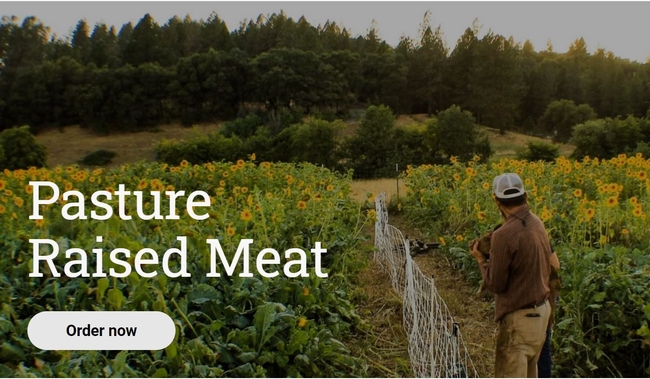
Funded by a USDA Farmers Market Promotion Program (FMPP) grant, the webinar series is part of a three-year project, Strengthening California Local Food Networks with Agritourism and Direct Sales, which provides trainings and technical assistance to farmers and ranchers on how to diversify their revenue streams.
The strength of the series, which includes eight webinars that were recorded earlier this year and are available online, lies in the collaborations among the UC SAREP Agritourism Program, UCCE, community groups, and farmers and ranchers.
The series features a range of speakers, including representatives from community organizations, technical experts, academic researchers, and farmers – all coming together to build resilience and adaptability for small-farming operations and the agritourism industry across California during the pandemic and after.
“It's great to collaborate with other organizations and regions, to learn from each other and to broaden our networks, as we are all working to create more resilient and sustainable food systems,” said Carmen Snyder, executive director of Sonoma County Farm Trails, one of the nonprofit partners on this project.
And because of those strong partnerships, the webinar topics reflected the on-the-ground needs facing agricultural producers.
“COVID initially dramatically affected farmers' restaurant contracts, with many losing more than 80% of their accounts overnight,” Snyder said. “CSAs [Community Supported Agriculture], on the other hand, couldn't keep up with the demand, and all of our CSA members were full and had wait lists for the first time ever. Producers pivoted by creating more online stores, including pick-up and delivery options. It was a challenge for them to navigate the new technology and platforms.”
Unsurprisingly, two of the more popular webinars were “Online Sales Options and Methods” and “Safe, Healthy and Successful Farm Stands”.
The “Online Sales Options and Methods” webinar, a partnership with the Community Alliance with Family Farmers (CAFF), provided an overview of several e-commerce marketing and online sales strategies that farmers can implement to diversify their revenue pathways and reach new customers. CAFF stressed the importance of farmers enhancing their resiliency through e-commerce.
The webinar also featured Ciara Shapiro, the owner of AM Ranch in Penn Valley, who shared her experience with online marketing and how it helped her and her husband survive the pandemic when the restaurants and farmers markets they sold to shut down. This personal and informative webinar demonstrated the effectiveness of online sales and marketing, while highlighting available resources from groups like CAFF.
The “Safe, Healthy and Successful Farm Stands” webinar was aimed at farms of all sizes and organizations that operate or advise agricultural operations using farm stands as a form of revenue. The webinar provided an outline of the rules and regulations that farm stand operators needed to follow during COVID – as well as during business-as-usual times.
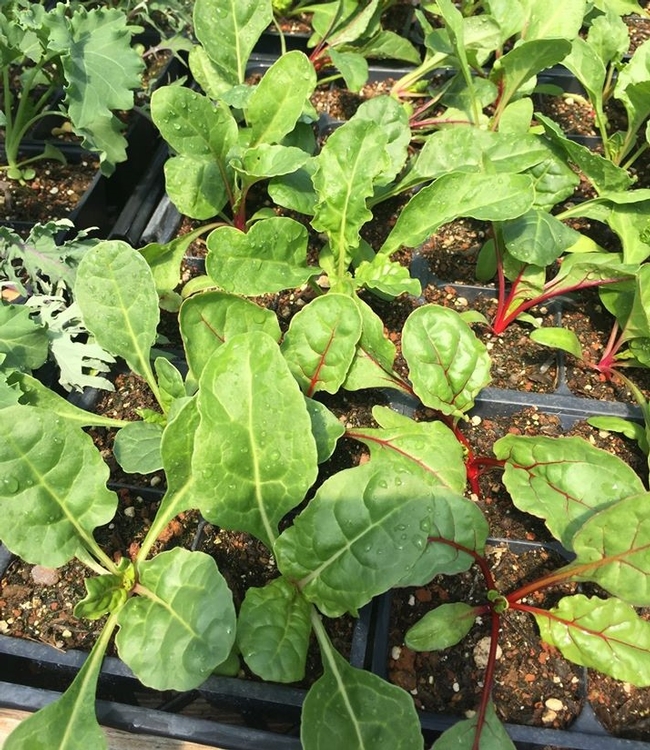
Both farmers saw an increase in farm stand business during the pandemic, which Yagi attributed to the “traffic storm of people” who attended their annual plant sale fundraiser and came to participate in new farm outdoor activities and volunteer opportunities. Yagi also noted the growing number of low-income individuals who were unable to access fresh produce during the pandemic.
The speakers' shared experiences running successful farm stands gave audience members tangible examples and real-time information on how to incorporate farm stands into their businesses.
Carmen Snyder of Sonoma County Farm Trails, which helped circulate the recorded webinars to their network of farmers and ranchers, remarked: “These webinars were extremely helpful for local producers, to get clarity on best pandemic practices during these challenging times and to learn how other producers are adapting and navigating the circumstances.”

